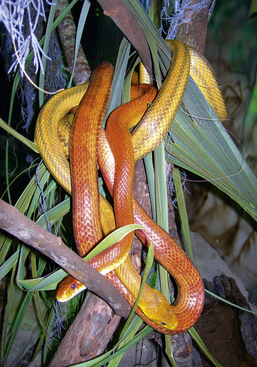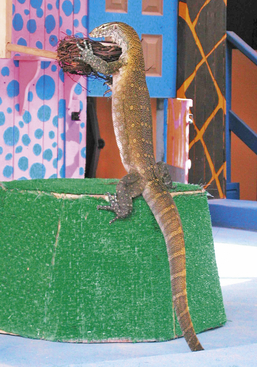Chapter 11
Conditioning and Behavioral Training in Reptiles
Enrichment
Based on the aforementioned definition, there are three main goals for enrichment:
All three of these goals require a clear understanding of the animals’ natural history. This information is critical to making the enrichment successful. Based on the natural history, each enrichment initiative should have a behavioral goal. One benefit of setting behavioral goals for enrichment is that it offers a way to measure our success. For example, a client may want to encourage an overweight arboreal snake to climb and utilize more of the enclosure. The question the client would ask is, “Did the addition of branches into the snake enclosure encourage the snake to climb and utilize the enclosure?” If the answer is yes, the behavioral goal was achieved. If the answer is no, then other options such as platforms, heat sources, or even different types of branches may be explored to encourage the snake to climb (Figure 11-1).
Choice of housing, enclosure furnishings, and behavioral opportunity depend on whether the reptile is arboreal, terrestrial, aquatic, or semiaquatic. Something as simple as providing different levels in an enclosure can encourage exploration and foraging. Many species of monitor lizard are known to stand bipedal to forage in the wild. This behavior can be recreated through minor alterations of an enclosure and delivery of food to the animal (Figure 11-2). Although animals in the wild seem to exhibit this behavior without much effort, a monitor lizard in captivity may need to be encouraged to stand through small and successive approximation. Captive lizards are likely novices at standing and will need to develop the skills and physical ability to accomplish some behavioral goals.
The way in which food is presented can also provide behavioral opportunity. Multiple behaviors can be encouraged by varying the size of the food item, the placement or location of the food, and the time of day of the feeding. For example, tree pythons are nocturnal; as such, their activity level typically increases at night. During the more active periods, foraging and hunting behaviors will be displayed. Therefore feeding during these periods could encourage active behaviors that stimulate and exercise the snake.
Encouraging your clients to study the natural history of the species they care for will be the first step in the creation of a successful enrichment program for their reptiles. Enrichment done appropriately will improve the health and well-being of the animal, enhance their welfare, and assist in facilitating their care. To find some additional examples of enrichment ideas, see Disney’s Animal Programs’ enrichment Web site at www.animalenrichment.org.1
Stay updated, free articles. Join our Telegram channel

Full access? Get Clinical Tree




